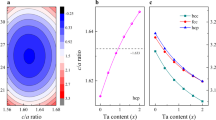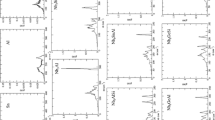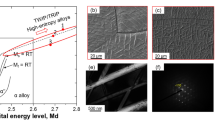Abstract
Recent studies suggest that the ratio of the shear modulus (G) to the bulk modulus (B) and the Poisson’s ratio (ν) are good indicators of ductility. Using the method of supercell and the first-principles pseudopotential plane-wave method, the G/B and ν of the β-type Ti-Mo binary alloys with Mo molar fraction (x Mo) ranging from 6.25% to 37.5% are calculated. The results show that the ductility of β-type Ti-Mo binary alloys first increases with increasing x Mo and reaches the maximum when x Mo is about 25%, and then reduces with more increasing x Mo. The charge density difference calculations suggest that the x Mo dependence of the ductility can be ascribed to the change of bonding characteristics between Ti and Mo atoms in the [111] direction.
Similar content being viewed by others
References
Oliveira N T C, Guastaldi A C. Electrochemical stability and corrosion resistance of Ti-Mo alloys for biomedical applications [J]. Acta Biomaterialia, 2009, 5(1): 399–405.
Raabe D, Sander B, Friak M, et al. Theory-guided bottom-up design of β-titanium alloys as biomaterials based on first-principles calculations: Theory and experiments [J]. Acta Materialia, 2007, 55(13): 4475–4487.
Ho W F, Ju C P, Chern Lin J H. Structure and properties of cast binary Ti-Mo alloys [J]. Biomaterials, 1999, 20(22): 2115–2122.
Ikehata H, Nagasako N, Furuta T, et al. First-principles calculations for development of low elastic modulus Ti alloys [J]. Physical Review B, 2004, 70(17):174113.
Oliveira N T C, Guastaldi A C. Electrochemical behavior of Ti-Mo alloys applied as biomaterial [J]. Corrosion Science, 2008, 50(4): 938–945.
Yao Qiang, Xing Hui, Meng Li-jun, et al. First-principles investigation of β phase stability and elastic property of Ti-Mo alloys [J]. Acta Metallurgica Sinica, 2008, 44(1): 19–22 (in Chinese).
Ho W F. A comparison of tensile properties and corrosion behavior of cast Ti-7.5Mo with c.p. Ti, Ti-15Mo and Ti-6Al-4V alloys [J]. Journal of Alloys and Compounds, 2008, 464(1–2): 580–583.
Song Y, Xu D S, Yang R, et al. Theoretical study of the effects of alloying elements on the strength and modulus of β-type bio-titanium alloys [J]. Materials Science and Engineering A, 1999, 260(1–2): 269–274.
Chen Yu-yong, Xu Li-juan, Liu Zhi-guang, et al. Microstructures and properties of titanium alloys Ti-Mo for dental use [J]. Transactions of Nonferrous Metals Society of China, 2006, 16(S2): S824–S828.
Cheng Y Q, Cao A J, Ma E. Correlation between the elastic modulus and the intrinsic plastic behavior of metallic glasses: The roles of atomic configuration and alloy composition [J]. Acta Materialia, 2009, 57(11): 3253–3267.
Hu Q M, Yang R. Mechanical properties of structural materials from first-principles [J]. Current Opinion in Solid State and Materials Science, 2006, 10(1): 19–25.
Pugh S F. Relations between the elastic moduli and the plastic properties of polycrystalline pure metals [J]. Philosophical Magazine Series 7, 1954, 45(367): 823–843.
Gao M C, Doganö N, King P, et al. The first-principles design of ductile refractory alloys [J]. JOM:The Journal of The Minerals, Metals and Materials Society, 2008, 60(7): 61–65.
Hu Q M, Yang R, Lu J M, et al. Effect of Zr on the properties of (TiZr)Ni alloys from first-principles calculations [J]. Physical Review B, 2007, 76(22): 224201.
Hill R. The elastic behavior of a crystalline aggregate [J]. Proceedings of the Physical Society. Section A, 1952, 65(5): 349–354.
Segall M D, Lindan P J D, Probert M J, et al. First-principles simulation: ideas, illustrations and the CASTEP code [J]. Journal of Physics: Condensed Matter, 2002, 14(11): 2717–2744.
Payne M C, Teter M P, Allan D C, et al. Iterative minimization techniques for ab initio total-energy calculations: Molecular dynamics and conjugate gradients [J]. Reviews of Modern Physics, 1992, 64(4): 1045–1097.
Perdew J P, Burke K, Ernzerhof M. Generalized gradient approximation made simple [J]. Physical Review Letters, 1996: 77(18): 3865–3868.
Born M. On the stability of crystal lattices. I [J]. Mathematical Proceedings of the Cambridge Philosophical Society, 1940, 36(2): 160–172.
Wang Y J, Wang C Y. Influence of the alloying element Re on the ideal tensile and shear strength of γ′-Ni3Al [J]. Scripta Materialia, 2009, 61(2): 197–200.
Gschneidner J R. K A, Ji M, Wang C Z, et al. Influence of the electronic structure on the ductile behavior of B2 CsCl-type AB intermetallics [J]. Acta Materialia, 2009, 57(19): 5876–5881.
Author information
Authors and Affiliations
Corresponding author
Additional information
Foundation item: the National Basic Research Program (973) of China (No. 2007CB613802), and the Research Fund of the State Key Laboratory of Solidification Processing of China (No. KP200912)
Rights and permissions
About this article
Cite this article
Lai, Mj., Xue, Xy., Zhou, Zb. et al. First-principles prediction of ductility in β-type Ti-Mo binary alloys. J. Shanghai Jiaotong Univ. (Sci.) 16, 227–230 (2011). https://doi.org/10.1007/s12204-011-1127-2
Received:
Published:
Issue Date:
DOI: https://doi.org/10.1007/s12204-011-1127-2




